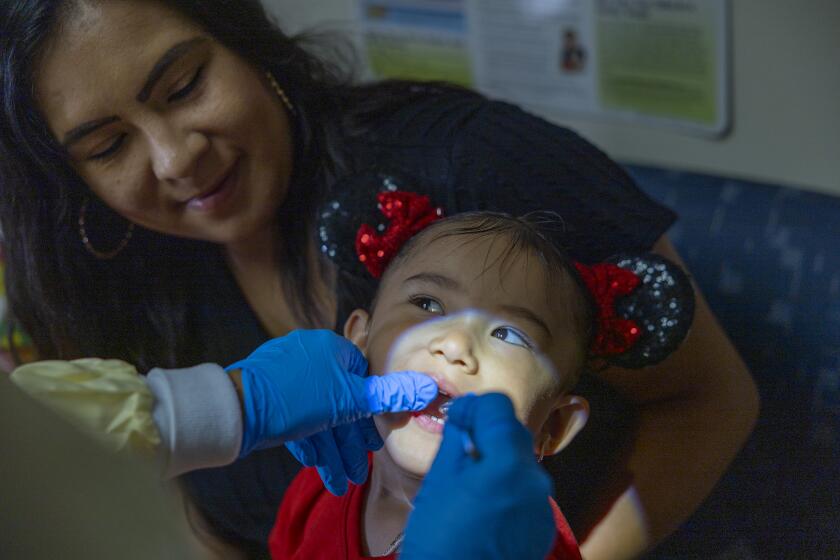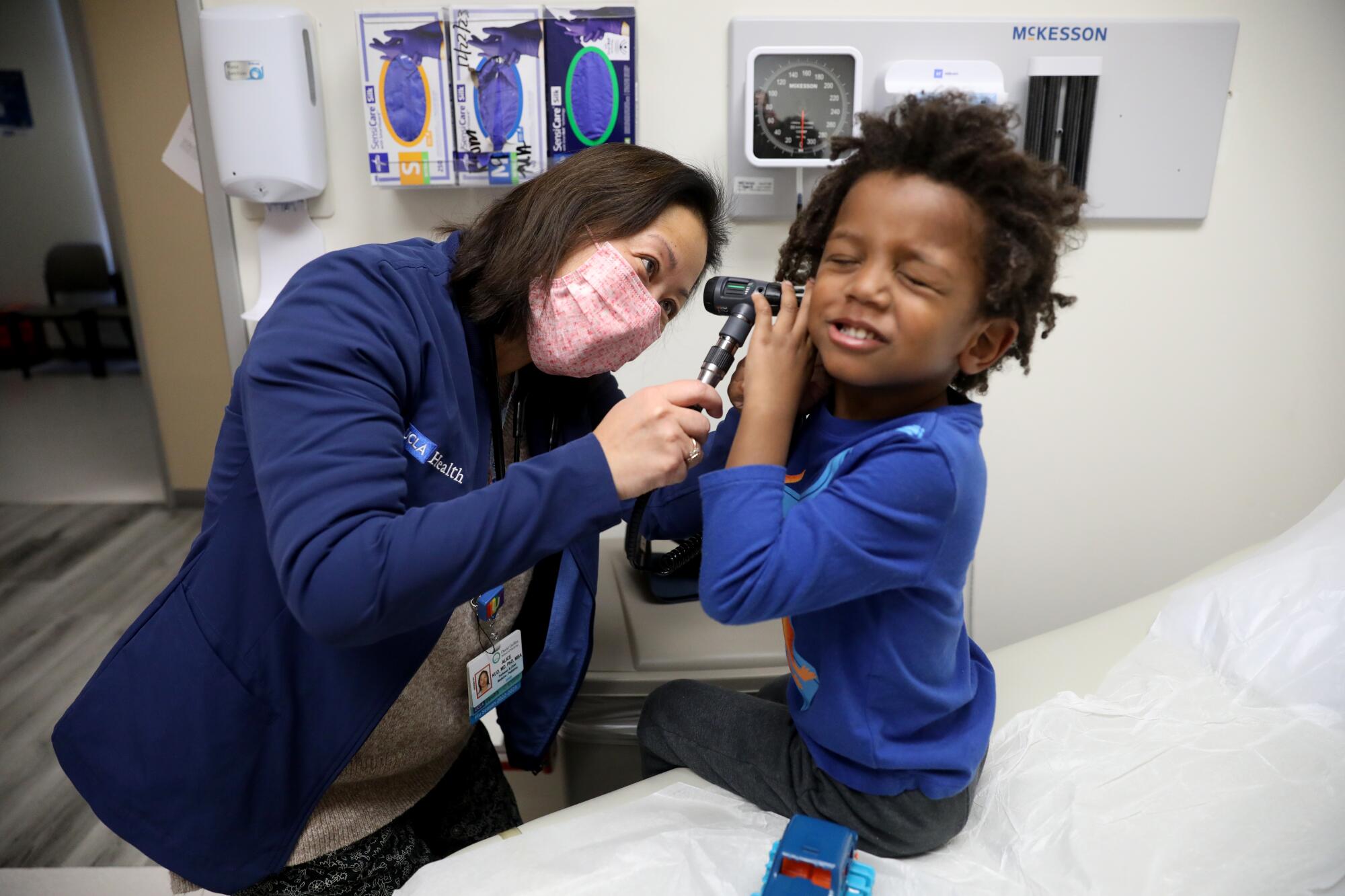
- Share via
Maria Mercado’s 5- and 7-year-old daughters haven’t been to the doctor for a check-up in two years. And it’s not for lack of trying.
Mercado, a factory worker in South Los Angeles, has called the pediatrician’s office over and over hoping to book an appointment for a well-child visit, only to be told there are no appointments available and to call back in a month. Sometimes, she waits on hold for an hour. Like more than half of children in California, Mercado’s daughters have Medi-Cal, the state’s health insurance program for low-income residents.
Her children are two years behind on their vaccinations. Mercado isn’t sure if they’re growing well, and they haven’t been screened for vision, hearing or developmental delays. Her older daughter has developed a stutter, and she worries the girl might need speech therapy.
“It is frustrating because as a mom, you want your kids to hit every milestone,” she said. “And if you see something’s going on and they’re not helping you, it’s like, what am I supposed to do at this point?”

California — where 97% of children have health insurance — ranks 46th out of all 50 states and the District of Columbia for providing a preventive care visit for kids 5 and under, according to a 2022 federal government survey. A recent report card from Children Now, a nonprofit advocacy group, rated California a D on children’s access to preventive care, despite the state’s A- grade for ensuring children have coverage.
The majority of California’s youngest residents — including 1.4 million children ages 5 and under — rely on Medi-Cal, an infrastructure ill-equipped to serve them. The state has been criticized in two consecutive audits in the past five years for failing to hold Medi-Cal insurance plans accountable for providing the necessary preventive care to the children they are paid to cover.
In a written response to questions from The Times, the Department of Health Care Services, the state agency in charge of the Medi-Cal program, said “improving children’s preventive care is one of DHCS’ top priorities,” and that the agency has recently addressed most of the shortcomings identified in the audits.
The department’s focus on the pandemic slowed action on the audit findings, the response said. State healthcare officials have since begun to more harshly fine plans that don’t provide adequate care and substantially boost payments to pediatricians to help increase access.
But information released publicly this month by the department suggests serious problems remain.
“In the whole scheme of the U.S. health system, I hate to say it, the youngest kids are always the ones that are overlooked,” said Dr. Alice Kuo, a pediatrician and health policy professor at UCLA.
According to state Medi-Cal data from 2021, the most recent year for which detailed data are available, and assessments from health experts, the impact is sobering:
- 60% of babies did not get their recommended well-child visits in the first 15 months of life. Access was even worse for Black babies — 75% did not receive their recommended screenings. Children who do not attend their well-child visits are more likely to go to the emergency room and be hospitalized for illnesses like asthma.
- 65% of 2-year-olds were not fully vaccinated, leaving them vulnerable to preventable diseases like measles and whooping cough.
- Half of children did not receive a lead screening by their second birthday; families may not know if their homes or other environments are unsafe, which raises the potential for irreversible damage.
- 71% of children did not receive their recommended developmental screening in their first three years. Without routine screenings, less than half of children with developmental or behavioral disorders are detected before kindergarten and miss out on early interventions.
“There’s a lot that happens in a well-child visit that keeps the child healthy in the immediate and the long term,” said Dr. Yasangi Jayasinha, a pediatrician with the Los Angeles County Department of Public Health. A doctor must ensure that a child is growing and developing normally, getting the proper nutrition, and help the family get plugged into other needed resources like food and housing assistance.
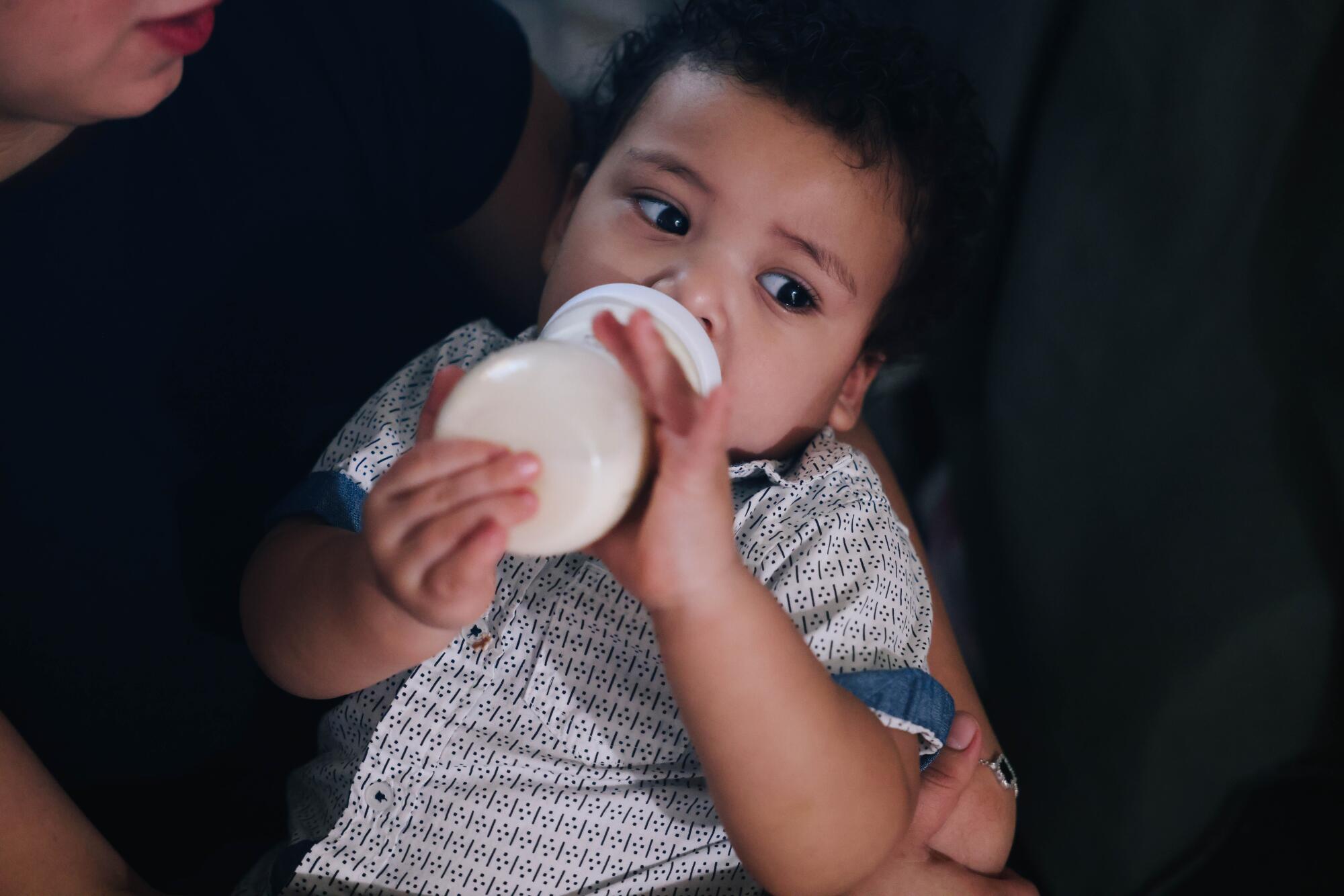
“No state is perfect, but it is particularly concerning that California isn’t at least in the middle of the pack, given its focus on young children and the importance of early brain development,” said Elisabeth Wright Burak, who studies child health policy at the Georgetown University McCourt School of Public Policy’s Center for Children and Families.
A growing problem
There are myriad reasons for California’s poor rates of preventive care for children, according to health experts across the state: a shortage of pediatricians who accept Medi-Cal, especially in rural parts of the state; transportation issues for families who don’t have a car; difficulties getting time off work to take a child to a doctor’s appointment; a byzantine Medi-Cal bureaucracy that makes coverage difficult to use for patients.
In 2019, a California State Auditor report found that less than half of children with Medi-Cal received their recommended preventive care. The audit blamed low reimbursement rates to Medi-Cal physicians, as well as poor state oversight, and gave the department a list of fixes.
Three years later, the auditor released a follow-up report, saying that the department had failed to fully implement eight of the 14 recommendations, including making sure directories of available providers are accurate and requiring health plans to address barriers to care.
The 2022 report found access had grown even worse, a decline largely attributed to the pandemic. Just 42% of children in Medi-Cal received their recommended preventive care. An average of 2.9 million children were missing out on care each year.
For the youngest children the results were particularly troubling: 60% of 1-year-olds and 73% of 2-year-olds in Medi‑Cal did not receive the required number of preventive services.
California ranks among the worst states for kids’ teeth with a lack of care partly to blame. With candy everywhere, Halloween is an extra scary time.
Although federal law requires that families have access to primary care within 10 miles or 30 minutes of their home, the health department had issued more than 10,000 exceptions. In Monterey County, for example, a healthcare plan requires families to travel up to 58 miles to see a pediatrician.
The department has since implemented all but one of the recommendations it agreed to, and is in the process of overhauling the Medi-Cal program, the response said. This includes beginning to levy higher fines against Medi-Cal plans that do not provide recommended well-child visits, vaccinations and lead screenings to enough children.
A spokesperson for the state auditor’s office said the department has not proved that it has implemented three of the recommendations.
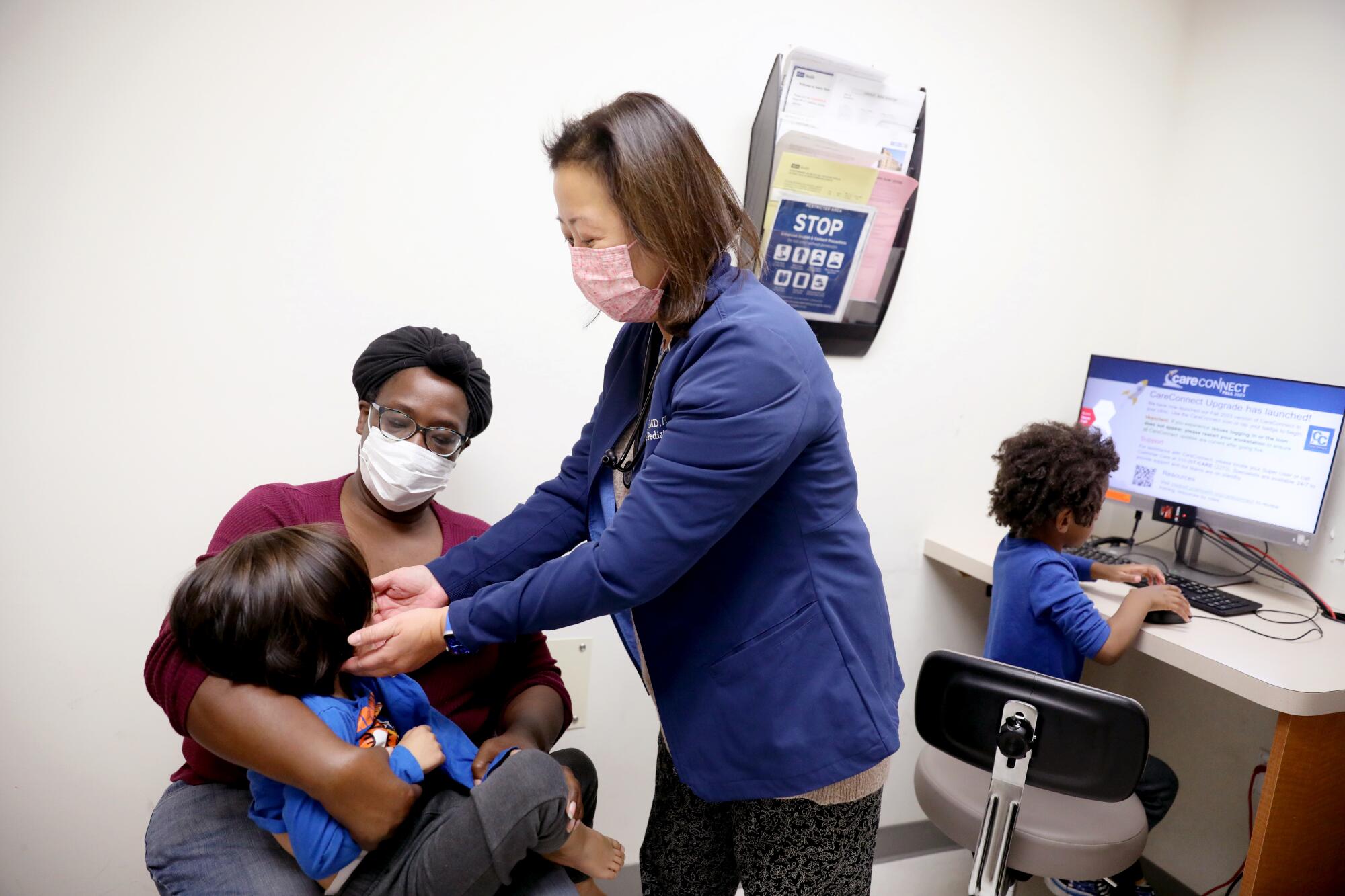
This month, the department announced assessments and fines for 2022. While DHCS reported some progress on access to well-child visits, the plans continued to struggle overall, and the quality of children’s healthcare lagged behind measures for other types of care, including behavioral health and chronic disease management.
Only one plan met all of the minimum standards on children’s health: Community Health Group Partnership Plan in San Diego. Eighteen out of 25 plans were fined $25,000-$890,000 for poor performance, including for children’s health.
Long waits, long drives
Parents and advocates say getting care for children remains a daily challenge. About 11 million Californians live in a primary care shortage area, where a pediatrician can be difficult to find.
“It’s most of the state, not just the Central Valley,” said Kathryn E. Phillips, an associate director at the California Health Care Foundation. California has not trained enough new doctors to meet the needs of the population, she said, and the current workforce is aging. In rural areas in particular, it can be difficult to recruit new pediatricians to join a practice.
Historically, Medi-Cal has paid doctors far less than other insurers, and the program has struggled to find enough willing to accept the rates. In 2021, for example, Medi-Cal paid $37 for a checkup with a toddler.
For the record:
2:27 p.m. Feb. 26, 2024An earlier version of this story incorrectly stated the name of pediatrician Eric Ball as Eric Bell.
“Medi-Cal patients basically don’t keep the lights on. You can’t make ends meet,” said Dr. Eric Ball, a pediatrician in Orange County. About a quarter of his patients have Medi-Cal, but the practice stays afloat because of payments from privately insured patients. That may change as the state has increased the Medi-Cal rates significantly this year, up to $116 for a toddler checkup.
In Los Angeles, families often face long wait times to get an appointment with a Medi-Cal provider— 82% of children in the county did not receive a developmental screening in the first three years, 2020 state data showed.
At UCLA, Kuo said patients at her practice must book their well-child visits three to six months in advance. “We get patients coming from Palm Springs to UCLA because there’s no access.”
Many Californians — especially those with low incomes — can’t afford the costs or time to make such a long drive, especially for the multiple visits recommended each year for a baby or toddler. Medi-Cal provides a transportation benefit to members, but many families don’t know it exists or say it is difficult to arrange.
“Families are so stressed about housing. They’re stressed about the price of gas. The cost of living here is so high,” said Dr. Lisa Chamberlain, a professor of pediatrics at the Stanford School of Medicine. A doctor’s visit for a seemingly healthy child is “just not going to make it to the top of the list.”
Rosa Benito, 21, lives with her parents and five siblings in Thermal, a town in Riverside County, where the family works in agricultural fields. Getting her siblings to the doctor is a constant struggle.
“We just have my dad and his little gray car, ” she said. The family goes to a clinic in Moreno Valley, over an hour away, but it’s only open during the workday, and their farming jobs don’t offer sick time. Taking a child to the doctor means missing work, which they can’t afford.
And since her parents lack documentation to be in the country legally, they’re scared of the long travel to the clinic for fear that they’ll be pulled over by Border Patrol. “It just turns into a bigger problem. The kids would be without a guardian,” explained Benito. Unless there’s an emergency, the trip often isn’t worth it.
Luz Gallegos of TODEC, a legal center in the Inland Empire serving immigrants and farmworkers, said many families stick with traditional “remedios” for their children and only bring them to the doctor for vaccines when it’s time to enroll in kindergarten. Some have lingering fears that using their child’s Medi-Cal benefits could affect their immigration status.
“Our families don’t think about prevention. They think about surviving.”
The Medi-Cal problem
While family challenges can play a role in missed visits, the state auditor found that the blame for California’s poor performance fell largely on the Medi-Cal program.
“By failing to prioritize implementing our recommendations, DHCS has... left certain children at risk of lifelong health consequences,” the auditors wrote in their 2022 report.
Celia Valdez, director of health outreach and navigation at Maternal Child Health Access, an L.A. nonprofit that manages several social service programs, says they hear daily from families who don’t know how to navigate the Medi-Cal bureaucracy: missing insurance cards, an unexplained switch in their assigned pediatrician, coverage that is suddenly terminated. “People are lost, and by the time they get to someone who can help them, critical time has passed,” said Valdez.

For Alexia Peralta of Hawthorne, the problems started about two months after her son was born last year, when his Medi-Cal enrollment went awry. She tried to book his 4-month well-child visit and was told he didn’t have coverage; she would have to pay $145 for the visit — an impossible sum.
She spent seven months in limbo — calling Medi-Cal repeatedly, waiting on hold for hours to speak with someone in Spanish, only to be disconnected. Several times, she thought she’d solved the problem, only to get to the pediatrician’s office and be turned away.
“I feel frustrated, mad and sad. I tried to get all these things for my child and got the run-around,” she said. He missed both his 4-month and 6-month vaccines.
Eventually, with the help of a home visitor from a Shields for Families program, a nonprofit in L.A., Peralta was able to get her son re-enrolled. At 15 months, he is still catching up on his vaccines.
Trying to fix the system
The health department said the challenges are not unique to California, and that the pandemic “resulted in large backlogs of children who needed to catch up on preventive services, a worsening crisis in the health care workforce, and limited additional capacity for pediatric services.”
In response, the department “has made historic investments and launched new initiatives” that “look to lift our youngest Californians and allow them to be healthy and to thrive.” This includes sending educational materials to families about recommended care, creating new contracts with Medi-Cal plans that more closely track children’s healthcare, and continuing to fine plans that fail to perform.
The state is also pumping money into the primary care workforce and is expanding residency and loan repayment programs. There are new Medi-Cal benefits to pay for doulas and community health workers, who can help patients navigate care, the response said.
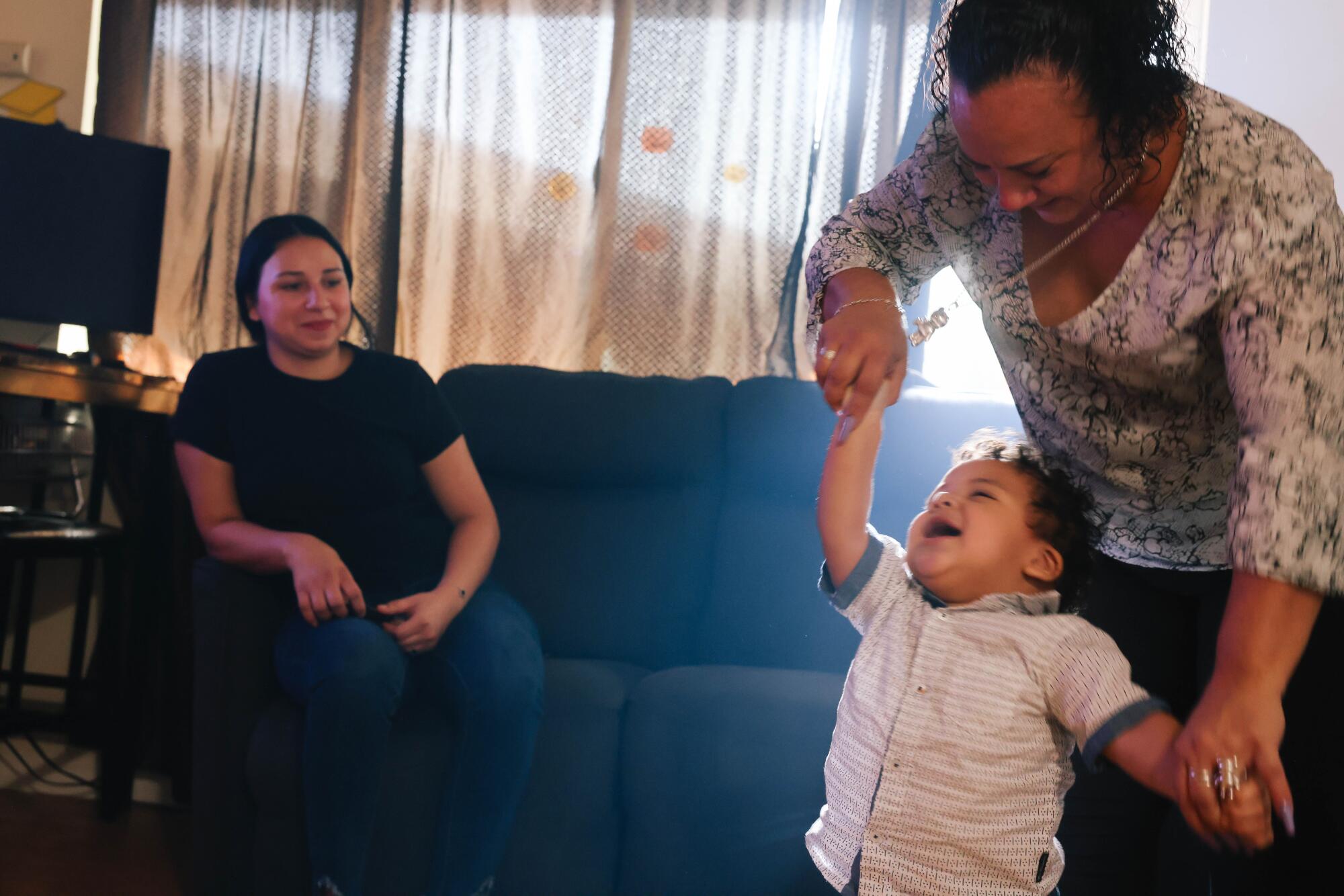
“The big ship is slowly turning,” said Mike Odeh, senior director of health at Children Now, who serves in an advisory group for the department. “But I want to emphasize how big the ship is and how hard it is to turn, given that we have decades of plans not providing care for kids. Changing that is going to take a lot of work.”
Former State Sen. Richard Pan, who was chair of the Health Committee before terming out in 2022, said he is not yet convinced the department’s response to the audits has been adequate. The devil is in the details, he said — are the fines against plans high enough? And how many plans will end up complying?
“Give us the proof that it’s been fixed. Show us the data. Unfortunately, I’m not in a position now to hold hearings, but I think that’s the next follow through,” he said. “The buck should always stop at the state.”
This article is part of The Times’ early childhood education initiative, focusing on the learning and development of California children from birth to age 5. For more information about the initiative and its philanthropic funders, go to latimes.com/earlyed.
More to Read
Sign up for Essential California
The most important California stories and recommendations in your inbox every morning.
You may occasionally receive promotional content from the Los Angeles Times.
